| Ulaanbaatar/ウランバートル (2003.06.24-2003.07.04) 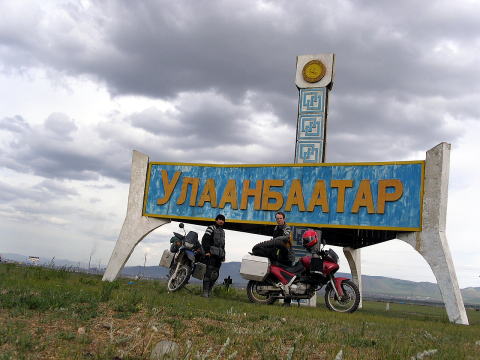 We took off for Mongolia on a cold, rainy morning. It was a 230 km trip to the Russian-Mongolian border. We finally made it to the frontier early in the afternoon, The border town was fairly quiet, with an air of tension. Getting across the border was a three-hour ordeal. Customs and immigration to get out of Russia took two hours. It seems like it took a long time for everyone, not just us travelers from afar. The bagage check was pretty rudimentary, and they accepted our word rather than digging through the bags. Procedures on the Mongolian side took just about an hour. We just filled out the immigration cards and the guy in charge stamped us into the country. Customs consisted mainly of some verbal questions about what is in our bags. The difference from the Russian side of the border made it obvious we were in a new country. The plains streched out to the horizon. Fortunately, the rain had stopped. But the sky was still a dark gray. We found out how far we had to go when we asked for the distance to Ulaanbaatar at a police checkpoint. The 360 km distance meant a five-hour trip, and it was too late for us to make it that day. Our first day on the plains was spent in our tents under the big Mongolian sky. A rest on our way to Ulaanbaatar the next day gave us a chance to meet the locals. We were invited into a Ger tent for (probably) goat's milk tea. The friendly nomads even let Daisuke ride one of their horses. Late afternoon saw us finally in the capitol of Ulaanbaatar at a guest house in the city center. There we were reunited with Kenji Nakayama who was on the same boat with us and Hiroyuki and Midori Nagahara who left Japan a week before us. All of our friends are staying for the Naadam festival starting in mid July. That means that from now on, we are in the lead across the continent. We spent full day in Ulaanbaatar, and then set out on a four-day, 500 km trip in search of rumored hot springs. The road out to the old Mongol empire capitol of Kharakorm was paved, but not in very good condition. Construction also meant that we had to take some detours across the plains. Past Kharkorm the route was on a main road, but that was mainly just the tracks of other vehicles. We encountered handle-grabbing sand and even had to cross a stream. The first night we camped out comfortably on the plains. Our trip to a hot spring the next day turned out to be a dud. Locals got us off in the general direction we needed to go, but we encountered a 15 meter wide river that needed to be crossed to reach our destination. Cattle crossing the river gave us an idea of how deep it was, and there were tracks of jeeps having recently crossed. But the weather was getting bad, and there was a good chance of the river getting even deeper before we made the return trip. The next day we set out for our second destination of Hojurt. While at the temple complex in Kharakorm on the way, we discovered that Chris's pannier case had broken. It was the same place as the break in Siberia, but on the opposite-side case. And Daisuke's chain adjuster had disappeared. The losses were nothing to stop our journey. but they are another hassle that needs to be overcome. We somehow managed to get to Hojurt. Our home for the night was a ger tent at the local tourist camp. There was a hot spring nearby, but it was not like the big baths we ware used to in Japan. The old lady at the camp brought us what we thought was mineral water, but it was really hot. Our conclusion was that the water was from the hot spring. At least the shower was hot. It may have been hot spring water, but we couldn't confirm that. There was no boilder nearby, however. Nearby was a sanitarium that locals were visiting for health reasons. Our hot spring trip ended in failure, and we made our way back to Ulaanbaatar. We head back to Russia as soon as parts to replace those broken in Siberia arrive for Chris's bike. One thing we can say is that Mongolia has been fairly easy on us. The food has been good, and we could get anyting we needed at the markets in UB or the towns we passed throught. That is more than we can say for Russia. 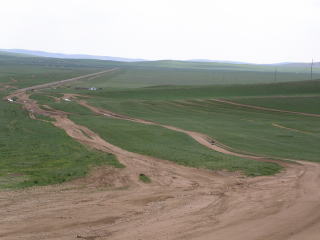 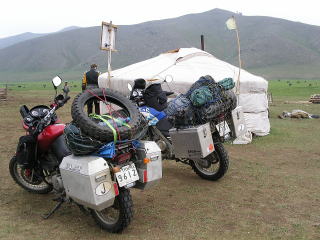 冷たい雨の降る朝、モンゴルへ向けて出発した。 モンゴル国境までは約230km、淡々と走り続ける。国境に到着したのは昼すぎだった。国境の町はどことなく緊張感を持ち、静けさを保っていた。国境通過には約3時間を所要した。まず、ロシア出国のための税関申告と出国審査で2時間。我々自身の手続きも時間がかかったが、前に並んでいる他の者の手続きを待つ時間もけっこうかかった。荷物は部分的に開けて見せたが、ほとんどは口頭申告で問題なかった(もちろん申告書はきちんと記載して提示した)。モンゴル入国のほうはざっと1時間程度。入国カードを記載した後、先方の高官と直接会って入国審査が行われたが、簡単に済んだ。税関申告もバッグの中身を口頭で申告するだけだった。 モンゴルに入ると、明らかに違う国なんだと実感させられるほど、果てしない大草原が続く。国境を越えるまでに雨は止んでいたが、曇天には変わりないのが残念だった。途中の検問所で止められた際に、警官にウランバートルまでの距離と時間を聞くと、360kmで5時間かかるという。この時点で17時をまわっていたので、当日中の首都入りは諦めて大草原の中にテントを張ることにした。 翌日、ウランバートルへの道の途中で休憩していると、遊牧民の夫婦が「ちょっと寄っていけ」という。遊牧民の住居であるゲルに入れてもらい、牛だか山羊だかの乳をご馳走になった。横江は馬にも乗せてもらった。 昼過ぎ、ウランバートル入り。中心街のゲストハウスに宿をとり、そこで船で同乗した中山さん、1週間前に出発した永原夫妻と合流した。彼らは7月中旬の祭典ナーダムまでモンゴルにいるらしいので、ここで我々が追い越すことになる。 中1日をウランバートルで過ごし、温泉を求めて4日ほど西方約500kmにあるというツェンケル・ジグールとホジルトに向かう。モンゴルの古都カラコラムまでは舗装路だが、舗装の状態が悪かったり工事中だったりでかなりの距離数を草原の迂回路に出ることになった。またカラコラム以降と目的地まで幹線からはずれた道は、草原の中に残る轍をたよりに進むダートだったが、こちらは砂地でハンドルをとられたり途中で川があったりとしんどかったが、大草原を駆ける愉悦は何ものにも代えがたい。 初日は草原の中で野宿をして快適だったのだが、2日目のツェンケル・ジグールは不発だった。道すがら地元の遊牧民たちに道を聞きながら草原の中を進むが、あと1歩というところで15mほどの幅の川が我々の行く手を阻んだ。牛や馬が渡っているのを見ると、確かにそれほど深くはないし、轍からジープなどの車は突破しているようだった。無理をすれば行けなくはないが、天気が崩れていているので増水する可能性がある。行っても帰ってこれないかも知れない。 そこであっさり諦めて、川の近くで野宿の準備を始めるが、突然雷鳴が轟き風雨が我々を襲う。間一髪でテントにもぐり込み、雷雨が去るのを待った。 翌日、2つめの目的地ホジルトに向かう。途中、カラコラムでエルデニ・ゾーという寺院を観光したが、そこで悪路のつけに気付いた。横江のチェーン調整のためのボルトが消えている(外れて落ちたらしい)。クリスのパニアケースの付け根が破損している(シベリアで破損したのと反対の方)。走るのに困らない状態にはしたが、これで疲労がどっときた。 疲労困憊状態でホジルトになんとか到着。ツーリストキャンプにあるゲルに宿泊する。ホジルトは温泉地であるが、いわゆる日本のような浴場は見あたらない。結果的に温泉であることを確認することはできなかったが、疑わしいものは存在した。まず我々の宿泊したゲルにおばちゃんが水差しを持ってきてくれた。ただのミネラルウォータかと思ったら、どうも温かい。これは飲泉ではないのか。次にシャワールームであるが、温かいお湯がちゃんと出る。味見をしてみたが、はっきりと温泉とは認識できなかった。しかし、その小屋の周辺に熱源らしき設備が見当たらなかったので引泉の可能性はある。さらに隣接している施設は、地元の医療用に使われているようだった。 こうして目的とした温泉については、不発&うやむやのうちにウランバートルへ戻ってきた。シベリアでの転倒時に破損したクリスの交換パーツが届き次第、ロシアに向けて出発する。 ちなみに、モンゴルの食事は非常にうまい。本当に今のところはずれがない。ゲストハウスでの滞在や町での買いものも至って快適である。ロシアに比べるといろいろな点でモンゴルは天国である。 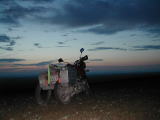 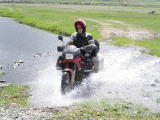 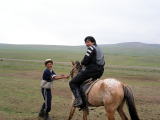 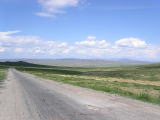 |
| <Siberia TOP> <Previous> <Next> |
